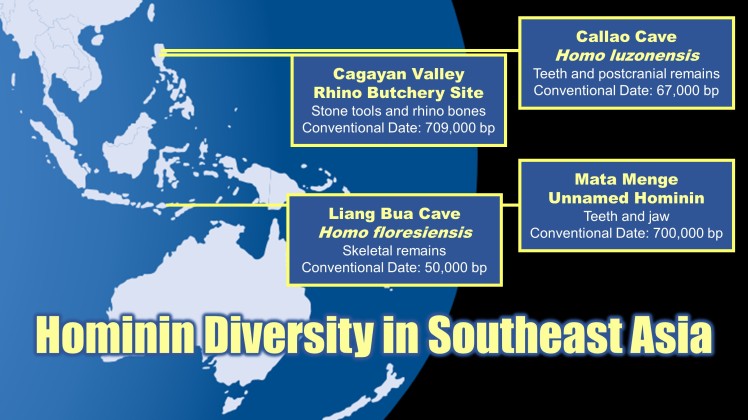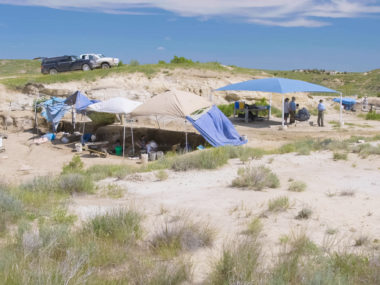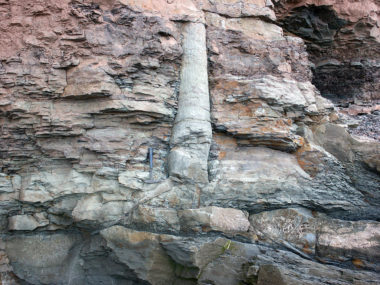Southeast Asia has long been a location of great interest in the study of fossil hominins. The remains of the famous “Java man” were discovered at a site called Trinil in Java, Indonesia in 1891. Additional fossils were discovered at the nearby site of Sangiran, where the unusual geology preserved the remains of many ancient creatures. Now classified as Homo erectus, these Indonesian hominin fossils from Trinil and Sangiran are some of the oldest conventionally dated hominin fossils outside of Africa.
The following article has been reblogged with permission from Humangenesis.org. The views expressed in this article reflect those of the author, and not necessarily those of New Creation.
More recently, the discovery of the “Hobbit” (Homo floresiensis) in Liang Bua cave on the island of Flores drew attention to the hominin diversity of southeast Asia. Three surprising aspects of Homo floresiensis distinguished these fossils from the nearby Homo erectus remains of Java. First, Homo floresiensis was much smaller at maturity than Homo erectus. Based on the partial skeleton of LB-1, Homo floresiensis was about three feet tall at maturity. Second, Homo floresiensis was also conventionally dated as much more recent than the Homo erectus fossils of Java. The Java fossils are thought to be more than a million years old, but the Flores fossils date to only about 50,000 years old.
Aside from the peculiar size and age of Homo floresiensis, the location of the fossils implied that these people had crossed about ten miles of open ocean. Even at the lowest ocean levels at the peak of northern glaciation, there was still no way to walk to Flores. The situation on Java was quite different. Many islands of western Indonesia and Malaysia, including Borneo, Java, and Sumatra, were once connected in one large, southeast Asian peninsula. Homo erectus could populate Java by simply walking there. Flores was never so accessible. Modern efforts to duplicate the crossing to Flores have shown just how difficult it is, with strong currents tending to push any thing on the surface far out to sea and away from the islands.
The presence of a unique human form like Homo floresiensis on an isolated island suggested that ancient humans might have actively crossed open ocean, but perhaps it was just a one-time thing? Maybe it was a freak accident during a strong storm? The fact that terrestrial mammal species generally do not cross this barrier between Flores and adjacent islands suggested that humans intentionally crossing the ocean was the more likely explanation.
Even before Homo floresiensis was discovered, however, paleoanthropologists expected to find ancient humans on Flores. Stone tools found at a site called Mata Menge, about 46 miles east of the Liang Bua Cave where H. floresiensis was found, revealed the presence of ancient people even without the actual fossils. In 2014, excavations at Mata Menge uncovered hominin teeth and jaw fragments that were small like H. floresiensis but also distinct from them. Unlike the remains at Liang Bua, however, Mata Menge’s stone tools and fossils were conventionally dated to 700,000 years ago. At the time, researchers did not assign these fragmentary fossils to a new species, but they definitely represent a form of tooth that is not the same as H. floresiensis.
In 2007, researchers excavating in the Callao Cave in the Philippines reported the discovery of a single, hominin foot bone, indicating that people had made it to the island of Luzon in the Philippines. Once again, this implied an active sea crossing, since Luzon was also never connected to the Asian mainland. Ongoing excavations at Callao Cave later uncovered even more remains, this time from hands, feet, a leg, and most importantly teeth. As with the teeth found on Flores, the teeth from Callao were unlike anything known from living humans or the fossil record, and these ancient people were named Homo luzonensis, after the island on which they lived.
Homo luzonensis was also a small-bodied people, probably less than four feet tall at maturity. They were conventionally dated to between 50,000 and 67,000 years before present. It is tempting to speculate about the connection of these people to the site of a rhinoceros butchery very nearby in the Cagayan Valley. The rhino site includes stone tools and rhino bones that have telltale cutmarks on them from the stone tools. Conventional dating of 709,000 years ago puts this site much earlier than the Calloa Cave people, making a direct connection between the two far more speculative than conclusive.

If we count the unusual teeth at Mata Menge, Homo luzonensis is the third small-bodied human form found in southeast Asia on an island that must have been reached by crossing open ocean. The presence of small-bodied people in these steamy jungles should come as no surprise – even today, the smallest living human people groups are all known from equatorial rain forests. What is surprising about these fossil forms is their diverse teeth, a diversity greater than anything we observe in living human beings.
What can a creationist make of all this? First of all, we can emphasize that these humans are all the remains of post-Flood populations dispersing over the earth after the tower of Babel. Given the early conventional dates, these humans were probably among the first to spread from Babel. Second, we can recognize in these human forms the same sort of diversity we witness at other locations, such as Africa or central Asia, where other humans like Neandertals or Homo erectus exhibit forms that no longer exist today. Third, we can marvel at the ingenuity of even these earliest of post-Flood humans as they crossed open ocean to reach what to them were uninhabited islands. Fourth, we can wonder about the diversity of these people and what caused it. Why do we not have this level of diversity in living populations? What happened?
Discoveries like Homo luzonensis make creation science an amazing enterprise. Each new discovery adds to our understanding of God’s creation and poses new questions and new opportunities to explore and learn even more!
Footnotes
Detroit et al. 2019. A new species of Homo from the Late Pleistocene of the Philipppines. Nature 568:181-186.
Ingicco et al. 2018. Earliest known hominin activity in the Philippines by 709 thousand years ago. Nature 557:233-237.
Mijares et al. 2010. New evidence for a 67,000-year-old human presence at Callao Cave,
Luzon, Philippines. Journal of Human Evolution 59:123-132.
Van den Bergh et al. 2016. Homo floresiensis-like fossils from the early Middle Pleistocene of Flores. Nature 534:245-248.












The idea of this group being one of the first to disperse is interesting. What do we mean by this?
Do we mean, simply, that they were literally the first to pack up their bags and take off? Or are we referring to the distance and the pace of their dispersion compared to the other groups? Or perhaps both.
It could be that these two factors influence rates of intermixing during the dispersion (if there was any of course).
Groups which moved first and fastest had less expoure to intermixing, thereby increasing their divergence potential in terms of speciation and the exacerbation of peculiar body features.
What would be interesting to see are the genomic phylogenic trees of H. florensiensis, luzoensis, modern man including people dwelling in equatorial rainforest regions.
And also to work out the cluster of genes that in combination contribute to the equatorial rainforest morphological phenotype, if that isn’t known already.